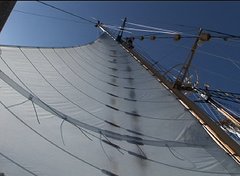Last night might have been one of the most exciting evenings ever on the Seamans with a Stanford@SEA class. With the help of people on shore who are providing satellite images of the ocean surface, we located and crossed a dynamic feature of oceanography and reacted quick enough to sample the physical oceanography and got a rare glimpse of what lives in the region.
The ocean is a dynamic place and when you look across the surface its often hard to "see" the distinctions between different water masses. But when we saw a booby fly over the ship at 4 p.m. so far from land, it should have been a sign that we were close to a large oasis in the sea.
After a super day of sailing at speeds as high as 8 knots we were moving steadily along on the evening watch when the science lab noticed the fluorescence climbing steadily, the surface temperatures warming and the salinity dropping. These were all signs that we were crossing from the North Equatorial Current (NEC) into a new water mass.
 A satellite image from David Foley of NOAA had just come through and we recognized that we were on an extension (that green "finger" on the left in the image above) of the Inter-Tropical Convergence Zone (ITCZ), a strong frontal zone that is approximately at 11o north. This finger, which extends as much as 200 miles north of the front, was a lunch spot for a leatherback sea turtle that's wearing a satellite tag. Stanford students Larisa Lehmer and Scot McCrackan are studying how leatherback sea turtles follow the frontal zones. They hypothesize the turtles use this tactic to forage on jellies. They think that these "fingers" serve as small buffet tables for the sea turtles, allowing them to dine on the rich resources yet remain on the cooler side of the front.
A satellite image from David Foley of NOAA had just come through and we recognized that we were on an extension (that green "finger" on the left in the image above) of the Inter-Tropical Convergence Zone (ITCZ), a strong frontal zone that is approximately at 11o north. This finger, which extends as much as 200 miles north of the front, was a lunch spot for a leatherback sea turtle that's wearing a satellite tag. Stanford students Larisa Lehmer and Scot McCrackan are studying how leatherback sea turtles follow the frontal zones. They hypothesize the turtles use this tactic to forage on jellies. They think that these "fingers" serve as small buffet tables for the sea turtles, allowing them to dine on the rich resources yet remain on the cooler side of the front.Leatherbacks are "gigantotherms" and are warm-bodied. The hot waters of the ITCZ may be too warm for their huge five- to six-foot bodies, and, by nibbling on jellies at the point of the convergence of the two water masses, they possibly gain a slight energetic advantage.
The ship passed through the finger and, as the fluorescence signal declined, SEA chief scientist Jeff Schell and I asked Captain Phil Sacks to turn the ship around -- quickly! The "B" watch team (the students work in groups, and take turns being on "watch" to sail the ship) conducted a rapid jib manuver, crossing 3 sails, and within 20' we were back on the feature. Here we once again jibbed and put the ship hove to (come to a stop, in landlubber language). At midnight, we tossed the CTD profiler in the water. We also threw out a series of nets. One was 2 meter net at a depth of 150 feet (50 meters) that caught more jellies than anyone had ever seen. A second was a bongo net for squid, which student Meridith Carpenter is studying. A third net was a neuston net to capture life in the surface waters. The team worked into the early morning hours but went to bed satisfied that the mystery of why the sea turtles forage along the frontal edges had for a moment been solved. -- Barb Block, chief scientist


No comments:
Post a Comment